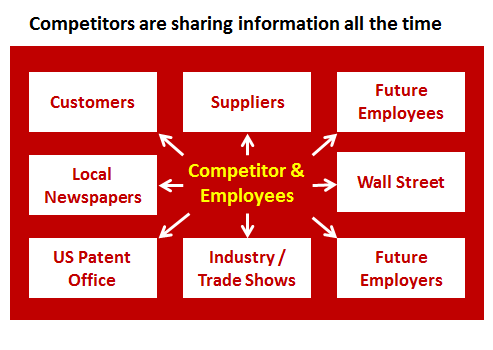When I was working overseas, I was on a competitive intelligence project. It might sound super-crafty, and Mission-Impossible, but it was not. It was actually quite boring. Lots of meetings to share information, and try to piece together the competition’s strategy and tactics. Very ethical and process-driven initiative.
Competitive intelligence tips
- Linkedin resumes. People say all kinds of things on Linkedin.com. Once I did a market sizing partially based on resume bullets (e.g., “I managed a $25M revenue product line of ABC product”). It’s amazing how much people will tell you about their projects. I guess personal pride trumps corporate discretion
- Who are they hiring? What kind of roles? Where are they hiring them? What are the key areas of responsibility? www.Indeed.com is the best.
- What patents are they filing? See what technology they are looking to fence in
- Search for presentation at www.Slideshare.net People post work stuff all the time
- What are the competitor’s suppliers and customers saying?. Suppliers know if the business is up, and what they are ordering. Customers can tell you a little bit about the sales pitches they have seen etc.
- What is the hometown newspaper saying? Small papers often run local stories (e.g., revenues etc) that get buried on the 10th page of Google results.
- Read forums. Forums are where people really speak their mind. Dig up industry forums and see what people are saying about a product or competitor. This also applies to all social media: your competitors facebook, twitter, instagram, etc.
- Conduct a survey. Pay people for interviews or conduct industry surveys to see what customers think about you and your competitors.
- Use word clouds. Take an online brochure from your competition, and copy/paste all the words and drop them into www.wordle.net See what the major words that keep getting repeated. Chances are those at the key attributes, benefits that the competitor is positioning on.
- Interview experts. There are numerous industry experts who pride themselves on knowing what is going on with ABC company or XYZ organization. Reach out. People love to be heard, and often, it is only a phone call away. On one project, we reach out to Wall Street analysts and even got a copy of their excel models.
- Download their 10K and investor relations presentations. If they are a publicly traded company, they are very transparent with their bosses (investors). Often time, they will come right out and tell you their strategy.
- Talk to your own sales people. Your sales people bump into their sales people all the time. They trade stories, bump into each other in lobbies, and often used to work together. Sales people know SOOO much about the competition, but often don’t realize that it is a gold mine for marketers.
- Scour trade shows. All B2B industries have trade shows where they show their wares to customers, vendors, and create alliances. Lots of brochures, opportunities to chat up vendors, and find out details.
- Refine an excel model. Your understanding of competitors improves over time. Put together a simplistic income statement for your competitors (what you know about their revenues (volumes x price), their cost-of-good-sold (materials, labor, production costs), their SGA (total headcount, overhead, sales channel) to estimate their profitability and product strengths. Test your assumptions.
- Analyze your own market share trends. Take the effort for real win-loss analysis by deal, by competitor. Often times, you know what your problem is, but are not admitting it. Institute a process and track market share over time. While this is commonplace for large B2B equipment makers, this is a best practice
- Look at the disruptors. Are you spending too much time looking at the predictable competitors? Don’t forget to look for disruptive innovation – the ones who are offering “less for less” like Hyundai in cars, or IKEA in furniture.
- Compare prices and features. Some companies have interactive design and quotation features on their websites. Essentially, you can price out a product that is equivalently “spec”ed to yours and compare the price and value. For example, configure your own John Deere tractor here.
- Search with key words. A few good key words to include in your google search: “site:org” for only websites from non-profits and industry groups, “forum” to find forum threads with the inside scoop, “pdf” for published materials.
- Create a safe and structured way to get information. Once you let your people know that this an important initiative, and it is ethical and useful, they will start to send you tid-bits of information. Piece all those together, and continually connect people within your company with data that is both helpful and strategic.
- Protect yourself. All these tips to find out more about your competitors are the exactly same tactics they are using on you. Teach your people to value information and explain how it can potentially harm the place they work.

